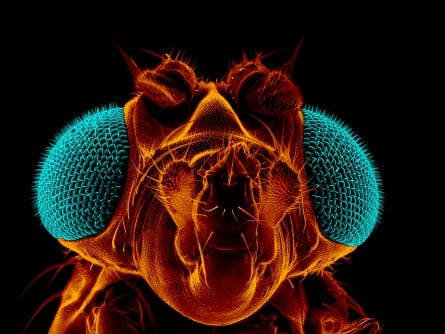Science
Scientists Discover How ‘Frazzled’ Protein Enhances Neuronal Communication

Researchers at Florida Atlantic University have identified a critical function of the protein known as “Frazzled,” or DCC in mammals, in the neural circuits of fruit flies. This discovery reveals how Frazzled facilitates rapid neuron communication and connection, crucial for all nervous systems, from insects to humans. The findings, published on March 15, 2024, in the journal eNeuro, provide insights into the mechanisms that ensure neurons form reliable connections, known as synapses.
The study concentrated on the Giant Fiber (GF) System of Drosophila, which controls the fruit fly’s swift escape reflex. The researchers demonstrated that when Frazzled is absent or mutated, the functioning of this neural circuit deteriorates. This results in improper electrical connections between neurons, causing slower neural responses and weakened communication with the muscles they regulate. Specifically, the study linked these deficiencies to a reduction in gap junctions, which are critical channels that allow direct and rapid signal transmission between neurons.
To delve deeper into Frazzled’s function, the scientists employed a genetic method called the UAS-GAL4 system, reintroducing various components of the Frazzled protein into mutant flies. Remarkably, the mere presence of the intracellular portion of Frazzled—located within the neuron and capable of influencing gene expression—was sufficient to restore both synaptic structure and neuronal communication speed. Disruptions to this portion, such as the deletion of a key domain named P3, led to failed restoration efforts, underscoring the importance of Frazzled’s role in gene activity regulation for gap junction formation.
The team also developed a computational model of the GF System, allowing them to simulate how varying numbers of gap junctions impact neuronal firing reliability. Their model revealed that even minor adjustments in gap junction density could significantly affect the speed and precision of neural signals.
Dr. Rodney Murphey, the study’s senior author and a professor of biological sciences at FAU, remarked, “The combination of experimental and computational work allowed us to see not just that Frazzled matters, but exactly how it shapes the connections that let neurons talk to each other.” He indicated that the next steps involve exploring whether similar mechanisms govern neural circuits in other species, including mammals, and how these mechanisms might influence learning, memory, or recovery after injury.
Interestingly, while Frazzled has traditionally been recognized as a guidance molecule that helps neurons grow in the correct directions, this study highlighted its role in regulating synapse formation. Flies lacking Frazzled displayed neurons that grew erratically, often missing their targets. By restoring the intracellular domain, the researchers corrected many of these navigation errors, revealing a dual function for Frazzled in both wiring neurons and refining their communication.
This work also draws connections to other organisms, with similar proteins in worms and vertebrates influencing chemical synapses. The findings suggest that Frazzled and its counterparts may play a broadly conserved role in shaping neural networks across different species.
By demonstrating how a single protein governs both the physical and functional aspects of electrical synapses, this research provides valuable insights into the fundamental principles of nervous system assembly. Dr. Murphey emphasized the significance of understanding how neurons establish dependable connections, stating, “Frazzled gives us a clear handle on one piece of that puzzle. Our findings could inform future studies of neural development, neurodegenerative diseases, and strategies to repair damaged circuits.”
The study’s co-authors include first author Juan Lopez, Ph.D., a postdoctoral researcher; Jana Boerner, Ph.D., managing director of the Advanced Cell Imaging Core at the FAU Stiles-Nicholson Brain Institute; Kelli Robbins, research staff in FAU’s Department of Biological Sciences; and Rodrigo Pena, Ph.D., an assistant professor of biological sciences at FAU.
Florida Atlantic University serves more than 32,000 undergraduate and graduate students across six campuses along Florida’s Southeast coast. Recognized as one of only 21 institutions nationwide with dual designations from the Carnegie Classification, FAU stands at the intersection of academic excellence and social mobility.
-

 Lifestyle3 months ago
Lifestyle3 months agoLibraries Challenge Rising E-Book Costs Amid Growing Demand
-

 Sports3 months ago
Sports3 months agoTyreek Hill Responds to Tua Tagovailoa’s Comments on Team Dynamics
-

 Sports3 months ago
Sports3 months agoLiverpool Secures Agreement to Sign Young Striker Will Wright
-

 Lifestyle3 months ago
Lifestyle3 months agoSave Your Split Tomatoes: Expert Tips for Gardeners
-

 Lifestyle3 months ago
Lifestyle3 months agoPrincess Beatrice’s Daughter Athena Joins Siblings at London Parade
-

 World3 months ago
World3 months agoWinter Storms Lash New South Wales with Snow, Flood Risks
-

 Science3 months ago
Science3 months agoTrump Administration Moves to Repeal Key Climate Regulation
-

 Business3 months ago
Business3 months agoSoFi Technologies Shares Slip 2% Following Insider Stock Sale
-

 Science2 months ago
Science2 months agoSan Francisco Hosts Unique Contest to Identify “Performative Males”
-

 Science3 months ago
Science3 months agoNew Tool Reveals Link Between Horse Coat Condition and Parasites
-

 Sports3 months ago
Sports3 months agoElon Musk Sculpture Travels From Utah to Yosemite National Park
-

 Science3 months ago
Science3 months agoNew Study Confirms Humans Transported Stonehenge Bluestones









